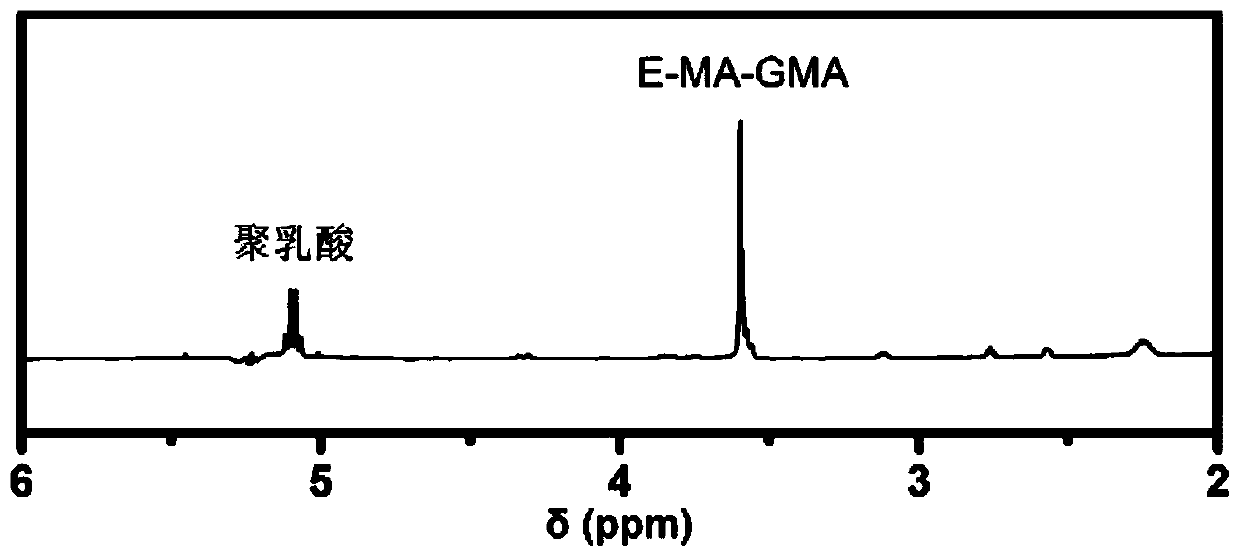High-performance stereocomplex polylactic acid/elastomer alloy material or product and preparation method thereof
An alloy material and elastomer technology, applied in the field of polylactic acid material and its preparation, can solve the problems of low toughening efficiency of PLA matrix, consumption of large petroleum resources, poor compatibility, etc., to achieve excellent melt stability characteristics and improve melt stability. the effect of improving compatibility
- Summary
- Abstract
- Description
- Claims
- Application Information
AI Technical Summary
Problems solved by technology
Method used
Image
Examples
Embodiment 1
[0038] The weight average molecular weight was 1.0×10 4 g / mol and 5.0×10 5 PLLA and PDLA with g / mol and optical purity of 92% and 99.5% respectively were vacuum-dried at 60°C until the water content was lower than 200ppm under a vacuum degree of less than 900Pa; Then mix it with 45 parts of PLLA, 45 parts of PDLA and 10 parts of E-GMA evenly; put the mixed material into the torque rheometer, melt and blend at a temperature of 210 ° C for 3 minutes, and granulate to obtain SC - Pellets of PLA / elastomer blend alloy. The obtained pellets had a degree of crystallinity of 35.8% and a melting temperature of 221°C.
[0039] The heat-resistant temperature of the product obtained by melting the above pellets at 240°C is 185°C, and the notched impact strength is 50.5kJ / m 2 .
Embodiment 2
[0041] The weight average molecular weight was 1.5×10 5 g / mol and 1.7×10 5 PLLA and PDLA with g / mol and optical purity of 98.5% and 99.5% respectively were vacuum-dried at 60°C until the moisture content was lower than 200ppm under a vacuum degree of less than 900Pa; Then it was stirred and mixed with 42.5 parts of PLLA, 42.5 parts of PDLA and 15 parts of E-MA-GMA; the mixture was added to the torque rheometer, melted and blended at a temperature of 200 ° C for 5 minutes, and granulated to obtain Pellets of SC-PLA / elastomer blend alloy. The obtained pellets had a degree of crystallinity of 42.5% and a melting temperature of 215°C.
[0042] The heat-resistant temperature of the product obtained by melting the above pellets at 240°C is 198°C, and the notched impact strength is 66.2kJ / m 2 .
Embodiment 3
[0044] The weight average molecular weight was 2.1×10 5 g / mol and 1.2×10 5 PLLA and PDLA with g / mol and optical purity of 98.5% and 99.5% respectively were vacuum-dried at 60°C until the moisture content was lower than 200ppm under a vacuum degree of less than 900Pa; Then it was mixed evenly with 37.5 parts of PLLA, 37.5 parts of PDLA and 25 parts of E-O-GMA; the mixed material was added to a torque rheometer, melted and blended at a temperature of 220 ° C for 7 minutes, and granulated to obtain SC- Pellets of PLA / elastomer blend alloy. The obtained pellets had a degree of crystallinity of 38.2% and a melting temperature of 223°C.
[0045] The heat-resistant temperature of the product obtained by melting the above pellets at 240°C is 188°C, and the notched impact strength is 69.3kJ / m 2 .
PUM
| Property | Measurement | Unit |
|---|---|---|
| optical purity | aaaaa | aaaaa |
| melting point | aaaaa | aaaaa |
| thermal resistance | aaaaa | aaaaa |
Abstract
Description
Claims
Application Information
 Login to View More
Login to View More - R&D
- Intellectual Property
- Life Sciences
- Materials
- Tech Scout
- Unparalleled Data Quality
- Higher Quality Content
- 60% Fewer Hallucinations
Browse by: Latest US Patents, China's latest patents, Technical Efficacy Thesaurus, Application Domain, Technology Topic, Popular Technical Reports.
© 2025 PatSnap. All rights reserved.Legal|Privacy policy|Modern Slavery Act Transparency Statement|Sitemap|About US| Contact US: help@patsnap.com



